Ryan Hall's Blog, page 337
October 15, 2015
Rallying For A Runner’s Cause In Memoriam
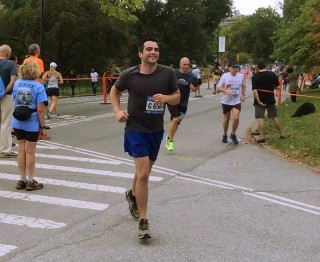
Eric Nadeau was a passionate and caring individual who was committed to run the 2015 TCS New York City Marathon for the Memorial Sloan Kettering Cancer Center.
Runners and friends of Eric Nadeau are helping extend his New York City Marathon fundraising efforts for the Memorial Sloan Kettering Cancer Center.
For 28 years, Eric Nadeau lived an active, athletic life. An energetic, ambitious and very passionate individual, Eric was a state champion and All-American wrestler in high school who later was a collegiate rugby star and enjoyed skiing and snowboarding. He also loved running and had run in several races over the past few years.
He was a native of Montreal, went to high school in North Carolina, earned a college degree at James Madison University in Virginia and also briefly lived in Australia, but he loved being a resident of New York City and living in Manhattan. His first job out of college was working in the sales department for the New York Islanders. For the past two years, he was a premium sales specialist for the New York Yankees.
Always active and on the go, Eric set a new goal to run the 2015 TCS New York City Marathon. He was determined and dedicated to running the race for the first time, but true to his character, it wasn’t just going to be about him.
He was entered in the Nov. 1 race that winds through New York’s five boroughs and was raising money for the Memorial Sloan Kettering Cancer Center. The money he raised through Fred’s Team would be going to support groundbreaking studies and clinical trials that impact the cancer community worldwide. He had been training for weeks and ran in the Oct. 10 Rock ‘n’ Roll Brooklyn Half Marathon, where he was headed to a personal best. But tragically, he collapsed and passed away just before crossing the finish line.
“Eric was probably the most passionate person about all aspects of life that I have ever worked beside and one of the most radiant people that I have ever known,” said Rose Barre, Manager of Premium Sales & Services with the New York Yankees, who was Eric’s boss both in the Yankees organization and previously at the New York Islanders. “Whether it was what he did during the day or on his own training for the Rock ‘n’ Roll Half Marathon in Brooklyn or the New York City Marathon in November, it was all about how he could improve and get the absolute best out of himself.”
As of last week, Eric had met his New York City Marathon goal of raising $3,500. Eric’s family and friends know how important running the New York City Marathon was to him and how inspired and motivated he was to be raising money for the Memorial Sloan Kettering Cancer Center. In his memory, his family has asked that the running community continue to help Eric raise money for the cause that was dear to him.
In the days since his passing, his goal has been increased and numerous friends and runners have donated to his cause.
DONATE: Contribute to the Memorial Sloan Kettering Cancer Center on Eric Nadeau’s Behalf
“Once you run one of our races, you are a member of our Competitor Group family forever, and Eric’s passing has crushed us all,” said Competitor Group SVP and Rock ‘n’ Roll series co-founder Tracy Sundlun. “He was a remarkable young man with so much living, doing and contributing in front of him. Our tears, love and support go out to his family and friends now and forever.”
The post Rallying For A Runner’s Cause In Memoriam appeared first on Competitor.com.
45 Reasons Why We Love the New York City Marathon
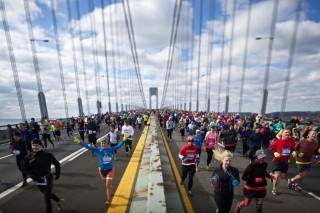
The Verrazano-Narrows Bridge serves as the start line for the marathon as runners charge across the bridge and are rewarded with breathtaking views of the New York Harbor and city skyline in the distance. Photo: Benjamin Norman
Since 1970, the race has become a monolith moment for both running and New York City. Here are 45 reasons why, after 45 years, the event remains a significant part of the city.
The Size
With more than 50,000 competitors annually, the New York City Marathon is the largest in the world. Last year, the average finish time was 4:34:45. All told, more than 1.3 million miles will be run across the five boroughs on marathon morning.
The Founder
Before founder Fred Lebow died of cancer in 1994, he ran 69 marathons in 30 countries, including an emotional finish in this race in 1992 after he was diagnosed with cancer. He also organized the Empire State Building Run Up and is immortalized in a statue in Central Park near the marathon’s finish line.
The Community
Even when the aftermath of Hurricane Sandy derailed the race in 2012, thousands showed up at Central Park in Manhattan and Prospect Park in Brooklyn and decided to run 26.2 miles anyway. Other runners donated time, effort and goods to hurricane relief.
The Equality
The marathon has been progressive in its treatment of women. The race is one of only a handful of events that has long offered equal prize money for male and female winners. The longtime chief executive officer of New York Road Runners, Mary Wittenberg, was the first female director of an international major marathon and one of the few female executives in sports. (Wittenberg is now the global chief executive of Richard Branson’s Virgin Sports.)
The Charm
The race inspires a humorous flurry of cheaters. More than 30 years after Rosie Ruiz famously fused running with subway riding in Boston, an investigation by The New York Times found that in a single year, several dozen runners still circumvented marathon rules and skipped parts of the course, either by sneaking into Central Park or handing off their electronic tracking sensors to faster runners.
The Wheelchair Division
Since it started in 2000, born out of a lawsuit from disabled athletes, the wheelchair competition at the marathon has grown to become one of the best in the world. “You race New York and they don’t see us as any different,” says Tatyana McFadden, a serial winner of the wheelchair race.
The Millionth
The millionth finisher, Katherine Slingluff, crossed the line last year and didn’t realize at the time she was the lucky competitor. Unintentionally inspirational, the Brooklyn resident completed the race as a 40-year-old mother of two.
The First
Running lore has it that the first-ever finisher of the race in 1970, Gary Muhrcke, received a recycled bowling trophy for his efforts. His time was 2:31:38.
The Signs
The New York City Marathon also inspires some of the greatest signage in sports. Runners are treated to an array of puns (“May the course be with you”), crass gags (“If a marathon was easy, it would be called your mother”) and a stream of Ryan Gosling faces.
The Attention
The New York City Marathon is one of the few moments that track and field geeks dominate airwaves outside of the Olympics. Watching the elites pour into the finish line goes well with…sleeping in and eating a decadent brunch.
The post 45 Reasons Why We Love the New York City Marathon appeared first on Competitor.com.
October 14, 2015
6 Dos and Don’ts for Running With a Stroller

Photo: Shutterstock.com
This article first appeared in Women’s Running.
If you’ve never run with a jogging stroller before, you might think it’s just like regular running with a really tiny running buddy. But stroller running is a whole other animal—a beast, really. It uses different muscles, takes a lot of patience, involves extra planning, and it’s just plain HARD. But it’s also a killer workout and a fun way to switch up your training when you want a challenge (or don’t have a babysitter).
If you’re thinking of adding a plus-one (or two, if you’re some kind of superwoman) to your next run, consider these dos and don’ts of running with the three-wheeled monster.
Don’t be disappointed by your pace
You probably assume you won’t run quite as fast with the stroller as you would without it, but you might be surprised by how slow you’ll actually go. Don’t get caught up by your pace; you’re probably pushing at least an extra 30 pounds so cut yourself some slack. But if you’re a runner who really needs to track herself, keep individual solo and stroller paces and work on improving each one separately.
Do pack for the apocalypse
After all the effort you put into getting you and your kid dressed and out the door, the last thing you want is to have to turn around a mile in because a little tummy is rumbling. This is where that extra planning comes into play—throw a bag of crackers or fruit and a bottle of water in the stroller basket so you can grab and distribute without breaking stride. And some small toys or books will go a long way when boredom (read: whining) kicks in. While you’re at it, make sure everyone makes a pit stop before you hit the road or bring a backup diaper for anyone who might need it. You may feel like a doomsday prepper but you’ll be mighty glad when you make it to mile 3 without a peep from the peanut gallery.
Don’t head for the hills
Pushing the stroller on a flat path can be exhausting enough, so trying to get up a hill can feel like a football sled drill in mid-July. Take it easy on yourself and stay on the straight and narrow, at least until you acclimate to stroller running. But if you’re feeling particularly tough and want to try a hill workout, remember to take it slow, engage your core, and most importantly—check those brakes before going downhill!
Do switch things up
You may find that it’s more comfortable pushing the stroller with one hand while pumping the other arm. That’s totally fine—just make sure you switch sides every few minutes, or you’ll end up with one very sore arm. The exception—make sure to keep both hands on deck when you’re on any kind of a downhill to avoid a runaway baby situation.
Don’t stay on sidewalks
If you’re lucky enough to live in a neighborhood filled with extra-wide, freshly paved sidewalks, then by all means, take advantage. But since most sidewalks have at least minor bumps, cracks or tree roots along the way that can make the ride uncomfortable and beat up your stroller, stick to the roads whenever safe, or pack up and head to a park with smooth routes. Both your stroller and your sidekick will thank you.
Do reap the rewards
When you’re struggling with the stroller, try and focus on the rewards coming your way. One of the biggest bonuses of a stroller run is that it’s a combination cardio and strength-training workout. You’re not just working your leg muscles here—your abs, shoulders and back play major roles in rolling those wheels so you’ll be rocking some muscles in no time. Another perk of all that pushing? You’ll earn some serious street cred and notice lots of nods of admiration from your fellow runners. Because almost anyone can run, but it takes a badass to stroller run.
RELATED: A Jogging Stroller Unlike Any You’ve Seen
The post 6 Dos and Don’ts for Running With a Stroller appeared first on Competitor.com.
From Nude Model to Elite Obstacle Course Racer

Laura Messner started the transformation into the popular obstacle-racing elite and social media star three years ago, though back then, no one knew her real name.
Today, people know her for her signature “Messner Pose,” popular posts on Facebook and Twitter and recognizable smile. She’s one of the most well-known obstacle-course racers in the world, in fact, even though she doesn’t quite match up with top elites such as Amelia Boone.
But on Aug. 10, 2012, Laura Messner was in fact a different person under a different name, and she knew nothing about obstacle course racing.
She was nervous and yet intrigued at the Spartan sprint race in Amesbury, Massachusetts. She loved the gym, was stronger than most women and needed to stay fit for modeling and singing, so she wasn’t intimidated. She entered the race for a fun workout.
The first sign that this race would be something more than that came before her wave, when a storm brought a sheeting rain, turning her mascara and war paint into black waterfalls that ran down her face. Again, she was a model, and her messy face made her self-conscious, and yet the people around her didn’t seem to care. Instead of staring at her or judging her, they fist-bumped her and asked her if she was ready to kick some ass.
She lined up and did this weird chant, the Spartan “aroo,” as if they were all tribal warriors, and about midway through the race, a funny thing happened. She found herself not caring about her face either. It was fun to be muddy and sweaty and blow snot rockets across her legs. That was, honestly, who she was. Growing up, she was a tomboy who liked to get dirty. But she craved approval, like most people, and after a lifetime of searching for it from her father, she found it from a photographer who got her started in modeling. She changed her voice, lifting her gruff tone to more of giggling lilt. She changed her hair from red to blonde, a blonde so extreme she had to sign waivers that absolved the salon of any responsibility if her hair fell out. She changed her name.
When she crossed the line that day, she was elated. She stared at her finisher’s medal dangling from her neck, and she realized she was not only happy, she was proud of herself.
She’d made herself happy. She hadn’t experienced anything like that in a long time.
And she didn’t need to take off her clothes to get it.
* * * *
Today, Messner is one of the most popular athletes in obstacle course racing, at least if you go by social media. On Facebook, for instance, you will find hundreds of examples of everyday Spartan racers in her signature pose, tagging it with #StrikeAMessner. Thousands follow her on Facebook and Twitter, and her posts, almost all of which are inspirational messages, garner hundreds of likes. More than a few ask to have their picture taken with her at races.
Her popularity is astounding, especially when you consider her ranking among the elite women. Messner, 25, is an elite competitor, and she places regularly in the top 10 (18 times in 25 races in 2014) and will typically win her age group. But she rarely finishes on the podium, even with her third-place finish in a Spartan race in Arizona earlier this year. She’s not a member of Spartan’s pro team, instead relying on a bevy of sponsors she got herself to cover travel costs to the more than 20 races she finished last year.
Messner, though, believes that may be part of her appeal. Many don’t know about her past as a nude model, but they can sense that Messner gets the same thing out of obstacle racing that they do, rather than just a desire to have a career.
“I’m more driven from the mental part of it,” Messner said. “I focus on how this is making me better as a person.”
In 2014, Messner decided to totally devote herself to OCR, and so she does consider herself a pro. Not only did she travel to all those events, and trained hard for them, she works as a personal trainer with MYLO Obstacle Fitness in Austin, Texas. She enjoys inspiring others, and she loves all obstacle-course racers, from the elites to the age-groupers to the ones just hoping to finish.
Messner needs the income from being a personal trainer, and that’s part of her motivation as well. Giving up nude modeling meant giving up her career, and she hasn’t found a way to replace the bulk of that income. It was a lucrative job, she said.
But just as she did as a pop singer or a model on the margins of popularity, she’s building her brand, only now she considers it giving something back to the people who she believes helped rescue her from what she now realizes was an unhappy life.
“She had a following, even a big one, as a model and a singer, but she was depressed from the emptiness of it,” said her mother, Abby Collins. “She believes the people in OCR like her because they genuinely admire her and love her. There’s just such a difference. She’s working her fan base now just like before. She’s always posting a picture and a message. But now she’s enjoying it as opposed to seeing that as a chore.”
Messner was a shy girl—“pretty much the opposite of what I am today,” she said—until the sixth grade, when she had a solo at a school choir concert. She loved the way she connected with the audience. She got lead roles in school plays and had an acting coach for a few years. She sang and posted professionally filmed videos singing covers on YouTube and Facebook.
She also loved to get pictures taken. Modeling, she said, was a natural next step from all that. It was fun and people told her she was good at it. In 2010 at age 20, she met up with a photographer who told her he could help her build her portfolio to help her do it full-time. “Show me a shoulder,” he said, and it went from there.
“I was nervous as hell the first time,” Messner said, “but I didn’t want to disappoint him. He probably picked up on that.”
Messner, in fact, craved the approval the photographer gave her, and the response she got from the resulting nude photos was all she needed. Messner threw together a persona and dove into modeling. It wasn’t a huge stretch—Messner was comfortable being naked her whole life, Collins said, and her mother admits she wishes she had her daughter’s body—but Messner knew even then she was pretending to be someone else.
She loved her mother, and her stepfather, a military man, helped her get through her most serious issues, such as an eating disorder that started at age 12 because he would command her to eat. But she wanted approval from her father most of all, and he never gave it. If anything, her new career drove him away even more, and yet she needed her career to make her feel special. Nude modeling became her specialty and her escape. It some ways it even lifted her out of the deep depression she felt from her father’s physical and emotional absence. She thought it was what she needed.
“Sexuality is an easily approved business,” Messner said. “It makes them feel good in the moment. It’s like a drug.”
She became so wrapped up in it, she wanted to legally change her name to the one she was using for her modeling and sometime singing career. (She doesn’t want that name in this article, for obvious reasons.)
Four years ago, she says a magazine offered to make her a centerfold, although a representative killed the deal after she refused to sleep with him, she said. Others approached her to star in porn movies, waving thousands of dollars in her face. Some of the photo shoots she did were pretty crazy, she said, but she never did hard-core images with another man. She’s proud of that today.
“At the end of the day, you start thinking about their story,” Messner said. “I view sex as something very personal and passionate, and I would have felt like a rag doll. I pictured myself watching myself doing that, and I asked myself if it would make me feel sexy. The answer was just the opposite.”
The post From Nude Model to Elite Obstacle Course Racer appeared first on Competitor.com.
Workout of the Week: Deuces Wild

Two-mile repeats are a great way to work on a variety of different training elements. Photo: www.shutterstock.com
Two-mile repeats serve up a variety of benefits, regardless of your training focus.
Seeing the words “2-mile” and “repeats” right next to each other before a workout may evoke feelings of uncertainty and nervousness, but after nailing one of these sessions I promise that you’ll come out of it more confident than when you started.
Deuces Wild is the name I’ve given to a plethora of different workouts consisting of 2-mile repeats at varying levels of intensity that will benefit experienced runners focusing on 5Ks, the marathon or anything in between. Here’s how you can make one of these workouts work for you:
5K-10K Training
Why: Running 2-mile repeats at half-marathon pace in the early to middle stages of a 5K-10K training cycle—i.e. 6-12 weeks before a peak race or series of goal races—will help smooth the transition back to regular speed workouts while building and maintaining strength for the faster, more race-specific sessions to come. As you get closer to race day, particularly for a 10K, 2-mile repeats at 10K pace are a great way to dial in race pace and develop confidence.
When, how many (and how fast): Once every 10-12 days in the 6-12 weeks before your goal race (or series of target races), run 2-4 x 2-mile repeats at half-marathon pace (roughly 15-20 seconds per mile slower than your 10K race pace) with 2-3 minutes jogging recovery between reps. Closer to race day, spread out the frequency of this workout to once every 14-16 days and manipulate the number of reps, the pace and the amount of recovery between repeats to suit your objectives. For example, 4-5 weeks out from a peak 10K race, try a workout of 3-4 x 2-mile repeats with the first mile of each repetition at half-marathon pace and the second at 10K pace. Take 3-4 minutes jogging recovery between reps. This is a good transition workout for experienced runners to practice dialing in 10K race pace while still maintaining an element of aerobic strength. Ten days out from a peak 10K race, running 3 x 2 miles at goal 10K pace with two minutes recovery between repeats is a great confidence building, race-specific workout to attempt prior stepping on the starting line.
Half-Marathon Training
Why: When preparing for a half-marathon, developing the specific endurance to run goal pace for 13.1 miles is best achieved through longer repeats that force you to run fast for a sustained period of time on tired legs. Two-mile repeats serve this purpose quite well; they’re long enough to be effective, but short enough to be digestible and keep you from getting bored or stale.
When, how many (and how fast): Starting early in a half-marathon training cycle, about 12 weeks before your target race, running 2-mile repeats once every 10 days or so is good practice for building the specific strength you’ll need to hold goal pace for the full 13.1 miles on race day. Start with 2-3 x 2 miles at goal half-marathon pace with 3-4 minutes jogging recovery between reps early on the in the training cycle. Over the course of three months, work on progressing to the point where you can do 4-5 x 2 miles at your goal half marathon pace with 2-3 minutes of steady running “recovery” between repeats 12-14 days before your goal race. To work on improving your efficiency as well as your ability to change gears, a session of 3-4 x 2-mile repeats with the first mile of each repetition at half-marathon pace and the second at 10K pace (3-4 minutes recovery between reps) is a good session to throw into the rotation 4-5 weeks out from race day.
Marathon Training
Why: For marathoners, 2-mile repeats at a variety of different paces are a great way to work on the elements of speed, strength and stamina over the course of a dedicated 12-week marathon training cycle.
When, how many (and how fast): The approach to incorporating 2-mile repeats into a marathon training schedule isn’t too much different than for someone getting ready for a half-marathon. Early in the training cycle, running 3 x 2 miles at a half-marathon pace (roughly 15-25 seconds per mile faster than marathon pace) with 2-3 minutes recovery between reps every once every 10 days or so is a great way to develop efficiency and build strength in preparation for the more specific marathon-paced workouts you’ll face in the final 8 weeks leading up to your goal race. Six weeks out from your goal marathon, a session of 3 x 2 miles, with the first and third repeats run at half-marathon pace and the middle 2 miles run at 10K pace (2 minutes recovery after the first rep, 4 minutes recovery after the second), is a good blend of strength and speed in the heart of a training cycle. Finally, in the 2-4 weeks before your goal marathon, alternating between marathon and half-marathon pace over a workout of 5-6 x 2-mile repeats is an awesome stamina-building, race-specific workout that will give you the confidence that you’re ready to tackle your 26.2-mile goal. After a 2-mile warmup, start with 2 miles at your goal marathon pace. Take 2 minutes recovery after finishing and then run 2 miles at half-marathon pace. After taking a 4-5 minute recovery, aim to repeat this 2 x 2-mile sequence 1-2 more times. Finish with an easy 2-mile cool down for a 14-16-mile day with 10-12 miles worth of quality running. Be warned: this is not a workout for the ill-prepared!
The post Workout of the Week: Deuces Wild appeared first on Competitor.com.
A Statistical Breakdown of the 2015 Chicago Marathon
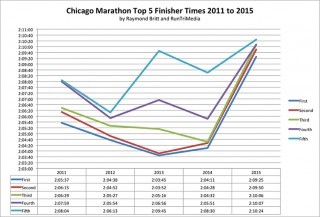
The 2015 Chicago Marathon continued to live up to its reputation as one of the most popular races in the world along several dimensions: a flat and fast course, more than a million cheering spectators, and thousands of top-notch volunteers. The entire city seemed to embrace the event again this year.
Here are some fast facts about the 2015 Marathon, which you may have already seen in media reports:
45,000 entrants are selected to run through a lottery, which had more than 70,000 applicants.
A total of 37,182 runners finished the race (20,144 men, 17,038 women)
Dickson Chumba won a slow men’s race in 2:09:25, while Florence Kiplagat won the women’s race in 2:23:33.
But let’s look deeper. The following 13 charts, compiled by Raymond Britt, takes a closer look at the results and answers a number of question. What was the average finish time overall? How are the finishers divided up by age group? How did average finish times compare to last year? How much slower is the second half of the race compared to the first?
Enjoy the trip through the analysis. For more of Britt’s in-depth histrocial analysis of Chicago, visit RaceChicago.org.
Photo Gallery
1 of {count}
Back to Start
View Larger Image

Average Finish Times By Division
View Larger Image

2015 Finishers by Age Group
View Larger Image

2014 vs. 2015 Average Finish Times by Age Group
View Larger Image

Average, First 13.1 and Last 13.1 Miles
View Larger Image

First 13.1 and Second 13.1 Splits by Division
View Larger Image

Splits and Finish Times, 2011-2015
View Larger Image

Finishers, 2011-2015
View Larger Image

Winning Times, 2011-2015
View Larger Image

Top 5 Finisher Times, 2011-2015
View Larger Image

2014 vs. 2015 Finishers by Female Age Group
View Larger Image

2014 vs. 2015 Finishers by Male Age Group
View Larger Image

Chicago Winner 5K Splits
View Larger Image

Chicago 5K Splits
Related Galleries
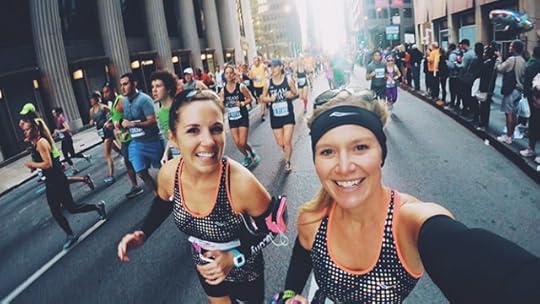
Photos: Saucony 26Strong at the Chicago Marathon
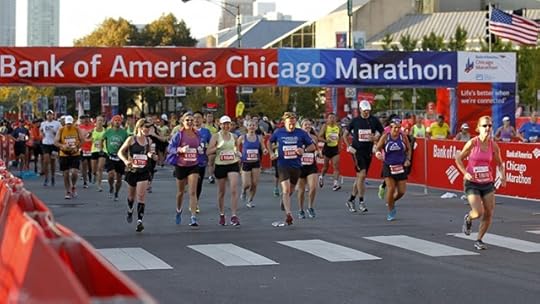
Photos: 2015 Chicago Marathon

15 Bucket-List Marathons in the United States

2013 Chicago Marathon By The Numbers

More Galleries
The post A Statistical Breakdown of the 2015 Chicago Marathon appeared first on Competitor.com.
Video: Watch the Trailer for Jesse Owens Film ‘Race’
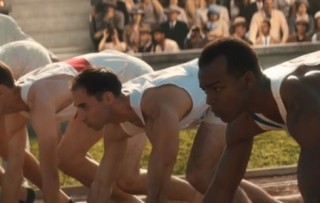
The incredible story of track and field legend Jesse Owens and his rise to the top of the sports world in the 1930s is coming to the big screen.
Owens won four gold medals at the 1936 Olympics in Berlin, winning the 100 meters, 200 meters, long jump and 400-meter relay—a feat not equalled until Carl Lewis matched it in 1984 in Los Angeles. A trailer for “Race” was released this week, a 3-minute preview of the film that hits theaters Feb. 19, 2016. The film, directed by Stephen Hopkins, stars Stephan James as Owens, and also features Jason Sudekis, Joe Shrapnel, Jeremy Irons, Anna Waterhouse and William Hurt.
Here is the trailer, which debuted today on Yahoo!:
The post Video: Watch the Trailer for Jesse Owens Film ‘Race’ appeared first on Competitor.com.
Remember When Back to the Future Part III Made Fun of Running?

Remember the Back to the Future movies from the ’80s and early ’90s? Well, they’re back in the spotlight this month.
As you may recall, in the 1989 film Back to the Future Part II, Marty McFly and Doc traveled into the future to October of 2015, where they encountered a very different world. Among the depictions now attracting amused interest in present day pop culture was that the Chicago Cubs were going to win the World Series for the first time since 1908 (which, heading into the National League Championship Series, is still a possibility). There was also depictions of flying cars, self-lacing Nike shoes, hoverboards and more.
The renewed interest in the Back to the Future series reminds us of one of our favorite exchanges, from the final movie of the series, Back to the Future Part III, released in 1990. In that film, Marty McFly travels back to 1885 to try and rescue Doc, and while in a saloon, Doc tries to enlighten a group of men about life in the future—including a hilarious exchange about running “for fun.”
RELATED: At the Movies: Memorable Running Scenes
The post Remember When Back to the Future Part III Made Fun of Running? appeared first on Competitor.com.
Rising Star: Sprinter Trayvon Bromell Turns Pro, Signs With New Balance
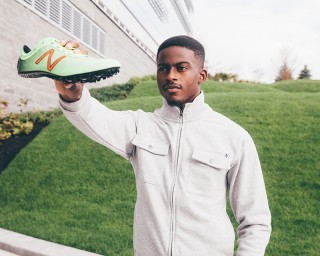
Trayvon Bromell, who earned a bronze medal in the 100-meter dash at the 2015 IAAF World Championships, turned pro and signed with New Balance this week. Photo: PhotoRun.net
Although he’s had a taste of success, Trayvon Bromell is a hungry kid who talks like he has an awful lot yet to prove as a runner.
The 20-year-old sprinter who says he grew up dirt poor in St. Petersburg, Fla., turned pro on Tuesday by signing an endorsement deal with New Balance, effectively ending his college running career at Baylor. It was a smart and definitive move, one that will put him on the fast track (or an even faster one) to reaching his still skyrocketing potential.
Like a lot of kids, Bromell dreamed about playing NFL football, a yearning so strong that he even quit track in middle school. But luckily for him, injuries derailed his football career early enough that he was able to listen to his mom’s advice and start developing his true calling that has already made him a once-in-a-generation talent.
“Speed is always something that excited me, but I didn’t really know where I was in track until my senior year in high school,” Bromell said Tuesday. “My mom kept saying, ‘You should run track.’ You should give it a try, don’t just quit on it.’ I kept pushing and working hard and getting stronger from my injuries and God blessed me with an opportunity, and I took advantage of it. Moms always know best.”
Already one of the world’s fastest sprinters, Bromell has experienced a meteoric rise the past three years. In 2013, he became the first high school runner to break 10 seconds in the 100 meters. Running for Baylor the past two years under the guidance of coach Mike Ford, he won an NCAA title in the 100 last year, an NCAA indoor title in the 200 this year and then ran an eye-popping 9.84 at this year’s U.S. outdoor track championships in Eugene, Ore., on his way to becoming the first American teenager to qualify for the IAAF World Championships in the 100-meter dash. He capped off a third straight amazing season on the track by claiming the bronze medal in the 100-meter final in Beijing behind Bolt and Gatlin.
So what’s next? Despite all that he’s accomplished, the sky appears to be the limit. And that’s why inking Bromell is such a big—and ultimately expensive—deal for New Balance.
But here’s the thing: Bromell certainly won’t reach his peak next year at the Rio Olympics and probably won’t approach it until at least the next Olympic cycle and maybe not even until the 2024 Games. Given the uber-competitive nature of the U.S. sprinting scene, he could have his work cut out just to make the U.S. Olympic team next year, both in the 100 and the 200. (Keep in mind that, as good as he is, he didn’t win the 100- or 200-meter NCAA outdoor titles in June, losing each one to Andre De Grasse, a Canadian, who runs for USC.)
So why is New Balance—a brand that thrives primarily because of the volume of shoes it sells to recreational distance runners—so interested in a young speedster like Bromell? Becuase he’s a guy who could take the mantle that all-world sprint king Usain Bolt will certainly vacate soon, most notably the one that carries the title of “The World’s Fastest Man.”
There are no guarantees, but Bromell appears to be that good.
While New Balance Vice President of Running Tom Carleo would love to see Bromell racing in Rio next summer, he’s banking on his future potential. If the kid continues his rise—which certainly seems likely based on the past three years—Bromell could become a household name around the world and, if he does, he’ll do it with a New Balance logo not far from his million-dollar smile.
“We build innovative product for the fastest athletes in the world and we look forward to working with Trayvon as he drives the future of U.S. and global sprinting,” Carleo said Tuesday. “In addition to his performance on the track, New Balance and Trayvon share a commitment to giving back which make him a natural fit for our brand.”
Bromell’s ascendency couldn’t come at a better time for American sprinting, which has been soiled by the doped-up legacies of aging champions Justin Gatlin and Tyson Gay. Gatlin and Gay, both 33, are still among the best in the U.S.—Gay 1on the 100 and Gatlin won the 200 at least year’s U.S. championships)—but they’ll be forever dogged by their positive drug tests and the negative connotation they carry.
That opportunity to ascend the throne isn’t lost on Bromell, but for now he’s taking it one step at a time. He’s not thinking about earning medals, just making his first Olympic team next summer. He doesn’t plan on changing a thing now that he’s a professional. He’ll continue to train under Ford with the Baylor program in Waco—and in, fact, he’s going to keep taking college classes.
“That’s the main goal for me,” Bromell said. “It would be a humbling experience just to make the team and be able to run at that level. Getting a medal would just be extra.”
The post Rising Star: Sprinter Trayvon Bromell Turns Pro, Signs With New Balance appeared first on Competitor.com.
October 13, 2015
Max King, Bridget Franek Win 2015 Warrior Dash World Championship
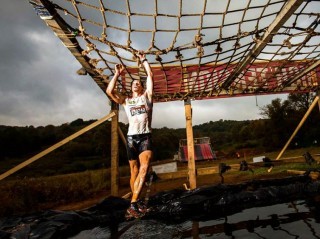
Max King maneuvers through an obstacle during the 2015 Warrior Dash World Championship on Oct. 10 in Pulaski, Tenn.
Being a fast and nimble runner in the 3,000-meter steeplechase on the track is paying huge dividends in obstacle racing for Max King and Bridget Franek.
King and Franek, both elite American steeplechase runners, used their speed and agility to win the 2015 Warrior Dash World Championship on Oct. 10 in Pulaski, Tenn., and each took home a whopping $30,000 paycheck for their efforts.
The 2015 Warrior Dash World Championship, which had a $100,000 total prize purse, was held on a hilly, 4-mile course at Milky Way Farm. Competitors had to crawl through mud pits, run through water, climb ropes, get over makeshift walls, maneuver over wooden barriers, run trails and swing through cargo nets.
The championship field included only participants who placed in the top 25 of a Warrior Dash earlier in the year and the top three male and female finishers from last year’s world championship. Several of the top competitors in each race were national-class distance runners.
“Yeah, (having steeplechase experience) seems to be a prerequisite to running well at some of these events,” King said Tuesday. “This one was more of a course built for runners, with what I would call efficiency-based obstacles. You’re crawling under, through obstacles, over obstacles, so it was fast. There weren’t really any strength-based challenges. It helps to have upper body strength, of course, but it was really about running fast.”
RELATED: Obstacle Course Racing Tips
King, a 35-year-old resident of Bend, Ore., won the men’s elite race in 27 minutes, 52.45 seconds, which meant he earned more than $1,000 per minute for what might be the slowest 4-mile race of his life. (King averaged just under 7 minutes per mile.)
“It’s the biggest prize purse in any running event I’ve ever won by far, and it’s great to have it,” said King, a Salomon-sponsored athlete who repeated his win in the Warrior Dash World Championships from the 2014 event held in Esparta, Calif. “I don’t even see the money. It goes straight to my wife and into a bank account.”
King has also won the 2011 World Mountain Running Championships, the 2014 IAU 100K World Championships and numerous U.S. trail running titles in the past 10 years. He’s also been a competitive marathoner (2:14:36 PR, 19th at 2012 U.S. Olympic Trials Marathon), 3,000-meter steeplechase competitor (8:30.54 PR, 6th at 2012 U.S. Olympic Trials) and adventure racer during his career.
King outran fellow elite runners Joshua McAdams (28:21, $10,000), a 2008 U.S. Olympian in the 3,000-meter steeplechase, Brett Hales (28:35, $5,000), a U.S. 2016 Olympic Trials Marathon qualifier, and top-tier obstacle course racer and 2:16 marathoner Hobie Call (28:41.70, $3,000) in what is believed to be the richest prize purse ever for such a short race.
Franek, 28, a 2012 U.S. Olympian in the 3,000-meter steeplechase from Eugene, Ore., was the women’s winner in 32:22, also taking home a $30,000 paycheck. She beat Kimber Mattox (32:48, $10,000), who recently represented the U.S. at the world mountain running chamoionship in Wales, K.K. Paul (35:10, $5,000) and Ali Morgan (36:03, $3,000), also a member of the U.S. mountain running team.
RELATED: Max King’s Mountain Running Insights
The post Max King, Bridget Franek Win 2015 Warrior Dash World Championship appeared first on Competitor.com.
Ryan Hall's Blog
- Ryan Hall's profile
- 21 followers



